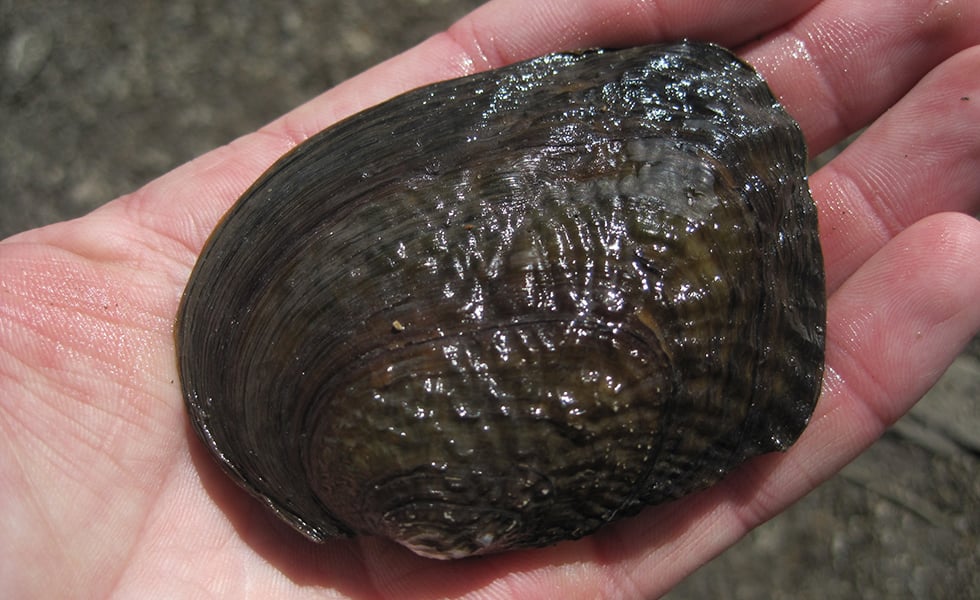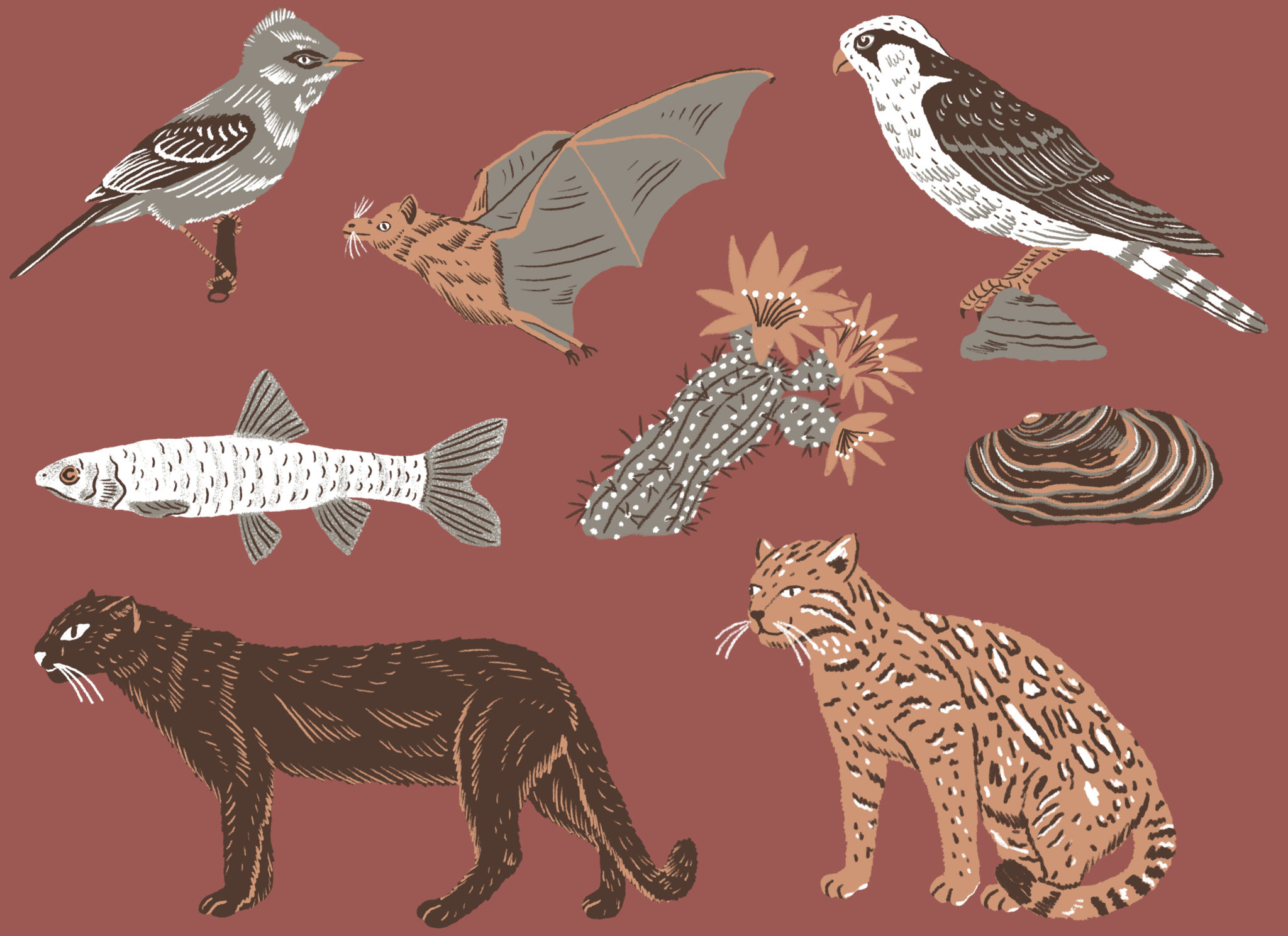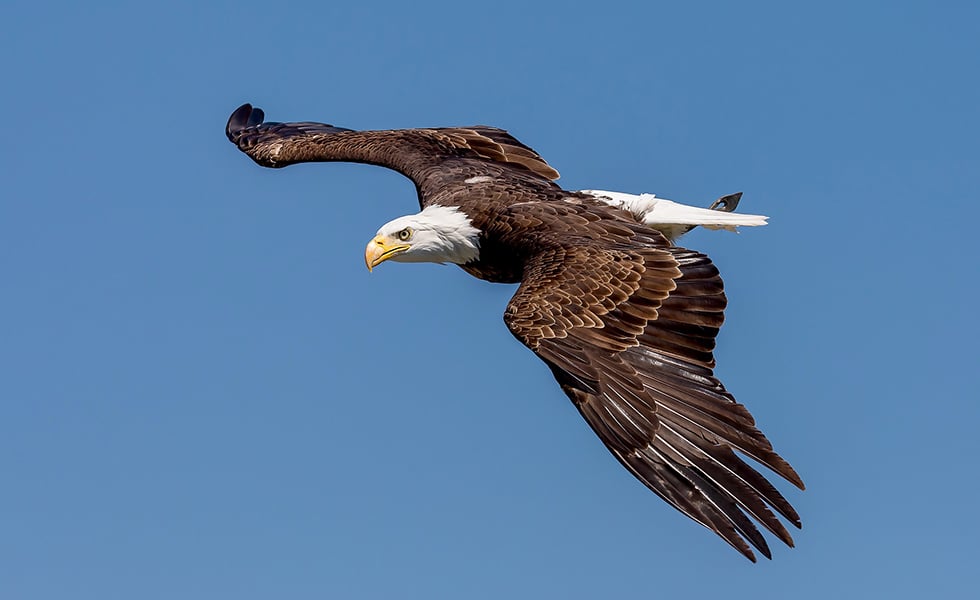
Bald Eagle Numbers at Lake Buchanan Are Declining. No One’s Exactly Sure Why.
From 2015 to 2019, an average of four birds per year came to Lake Buchanan—less than half of the 10.4 average for the five years before that. Could the noise from hunters be to blame?

Above: Annual surveys show that the bald eagles’ population has fallen to the lowest numbers since tracking efforts began in the late 1970s.
Tim Mohan is intimately familiar with Lake Buchanan, the northernmost of the six Highland Lakes that squiggle through the Hill Country toward Austin. The outdoorsman can point out all the most interesting spots: Barringer Hill, on Buchanan’s western side, where rare earth metals were discovered in 1886 but later were lost to the lake; Buzzards Roost Creek, where turkey vultures catch warm thermals in their unyielding quest for carrion; and the intermittent waterfall aptly dubbed Seldom Falls.
Most importantly, Mohan, a tour guide for Vanishing Texas River Cruises near the town of Burnet, knows about the bald eagles. Each year starting in November, the birds arrive from North America’s frigid northern expanses to temporarily roost in the scrub brush dotting Lake Buchanan’s austere canyon faces. Some are juveniles still honing their dive-bomb fishing technique; others are majestic, white-faced adults with eight-foot wingspans. “If you could see one of these mature birds, it’s phenomenal,” Mohan says. “It just knocks your socks off.”
On a chilly November morning, Mohan sits at the bow of a two-deck cruise vessel, binoculars in hand and a microphone affixed to his cheek. The boat charts a path northward as he regales the 60 or so passengers with trivia about the lake’s history (it was created by damming the Colorado River in 1939) and dimensions (measuring 31 miles long and five miles wide, it’s the largest of the Highland Lakes). But the spiel is merely a warm-up act for the main event: the bald eagles.
The problem is, there aren’t many to see today.
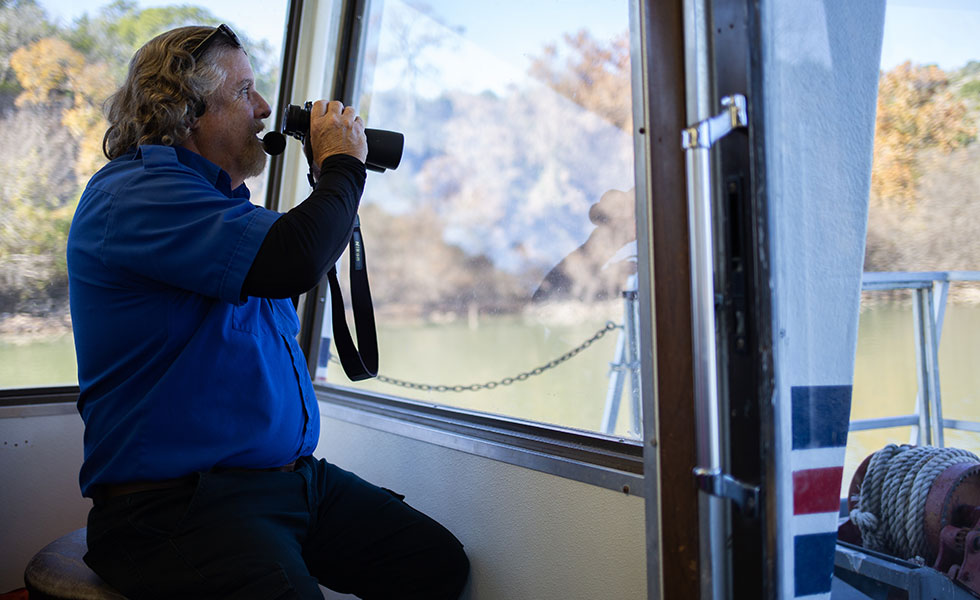
About halfway through the three-hour tour, there are no eagles to be found. Mohan’s frustration starts to show. “I’m more than a little irritated we haven’t spotted any yet,” he tells the passengers. “That’s just not right.” After all, the bald eagles are what folks come to see from across the state. Streets and housing developments in Burnet are named after our national bird; eagle-themed shirts, koozies, and wine stoppers are sold in the lakefront gift shop; even this vessel is named the Texas Eagle.
Mohan and others familiar with the visiting bald eagles say that their numbers on the lake seem to be dwindling. Annual surveys show that the birds’ population has fallen to the lowest numbers since tracking efforts began in the late 1970s. From 2015 to 2019, an average of four birds per year came to Lake Buchanan—less than half of the 10.4 average for the five years before that. And no one’s exactly sure why. Climate change has messed with the birds’ migratory patterns, pushing eagles from southern to northeastern states. But a theory is also being floated that hunters illegally shooting ducks on Lake Buchanan may also be driving the eagles away. “Last year, their numbers were down considerably. We speculated if it wasn’t due to duck hunters,” Mohan says.
It’s not just idle speculation—Mohan and Shawn Devaney, the boat’s captain, have seen duck hunters setting up blinds both on the shoreline and in the water, despite rules prohibiting hunting in the area. And last year, Mohan says, a hunting party let off a shot just as the boat passed. “It was loud. You could tell it was a shotgun going off.” Devaney notes that it’s impossible to know to what degree hunters are contributing to the decline in the number of birds in the area, “but a bunch of shotguns going off while eagles are trying to roost isn’t good.”
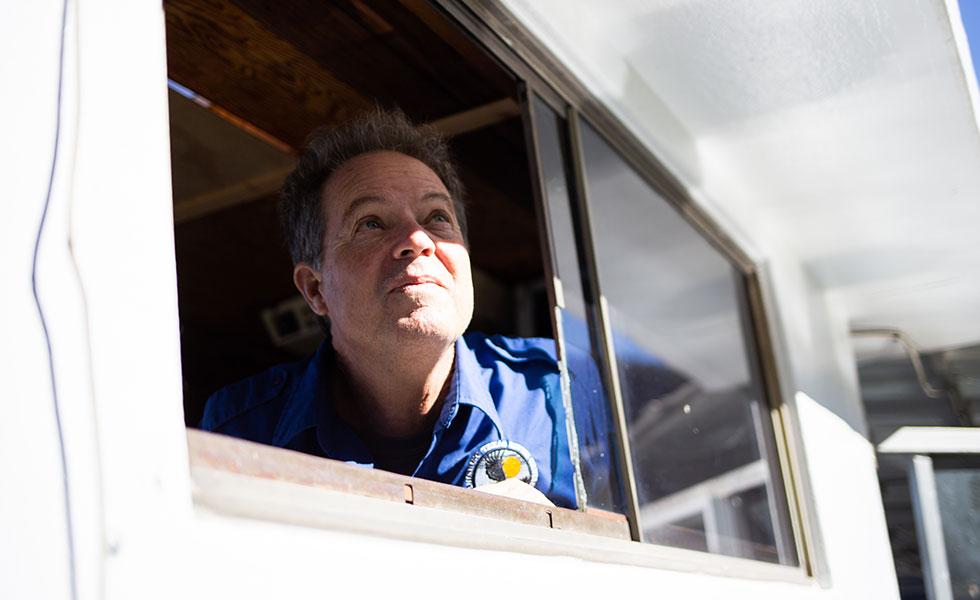
There’s evidence to suggest that loud noises could drive the birds away, especially in a river canyon where tall walls echo and amplify noises. Near Chicago in 2012, environmentalists cried foul when police proposed a new shooting range adjacent to wetlands where bald eagles nest; they said gun noises could put the city in violation of federal law prohibiting disturbing the birds (the eagles prevailed and the range wasn’t built). At the University of Minnesota, researchers are using sounds to drive bald eagles away from wind turbines, which endanger the birds during their annual migration. This year, university researchers in Ireland showed that noise created by humans has an outsized effect on birds and other species. “Consequently, anthropogenic noise must be considered as a serious form of environmental change and pollution,” it said.
Although the number of bald eagles roosting at Lake Buchanan seems to be dropping, nationwide the population is thriving. For the most part, the species has made a remarkable recovery since the 1970s, when it teetered on the brink of extinction. At that time, eagles were being killed by fisherman trying to protect their catches. They were also ravaged by the now-outlawed pesticide DDT, which was ingested by fish and then passed onto the eagles that ate them, making their eggs too fragile for chicks to reliably hatch.
In 1972, DDT was banned in the United States. One year later, the federal Endangered Species Act was passed and the bald eagle was listed as being endangered, granting it new protections. In the decades since, their numbers have bounced back so drastically that bald eagles were removed from the endangered species list in 1997. The laws, however, still forbid people from engaging in activities that would “disturb” the birds from breeding, feeding, or taking shelter.
The Lower Colorado River Authority (LCRA), which owns Lake Buchanan and the other Highland Lakes, forbids hunting on its water and land. A spokesperson told the Observer that it wasn’t aware of any duck hunting happening at Buchanan. LCRA employs “rangers” to police the lake, but citing “security reasons,” the spokesperson would not answer questions regarding how many of them are assigned to Buchanan or how frequently they patrol. Cody Hatfield, a supervisory state game warden who oversees compliance with state hunting rules in Burnet and surrounding counties, also said he hasn’t seen duck hunters on the lake—but he admits he doesn’t patrol the lake itself.
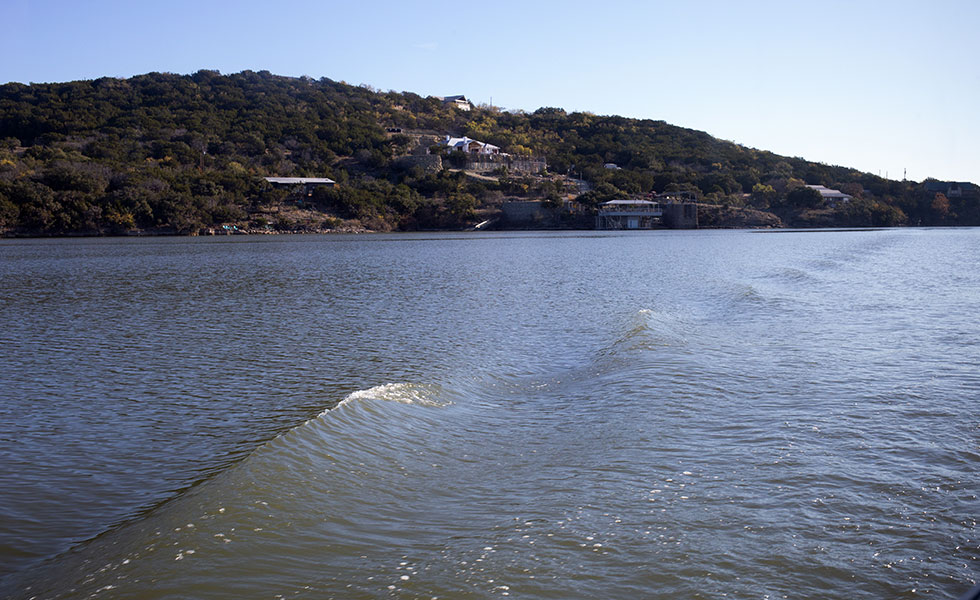
Charles Tishcler, who’s conducted the annual count of bald eagles every year since 1979, has seen the hunters. The first time was in 2015, when he spotted one wielding a “long-barreled goose gun” on a boat in the Canyon of the Eagles. Since then, he’s spied more: “They have their duck decoys out and it’s just like, boom, boom, boom. You’ve got three guys with automatic shotguns and it turns into quite the tune,” he says.
Tischler said he reported the hunting activity to LCRA and to the Texas Parks and Wildlife Department, which regulates hunting in the state. Nothing ever came of it, he says. Tischler fears that if officials allow hunting to continue in this area, the eagles may decide to roost somewhere else completely—leaving this rugged and wild part of the state without its seasonal mascot. “I thought we’d lose the eagles to straight-out [housing] development,” he says. “I never saw this coming.”
Back on the Texas Eagle, from the second deck, Devaney announces over a loudspeaker that he may have spotted the first bald eagle of the day: a juvenile, resting in a copse of cottonwood atop a cliff to the west. Tourists rush to the window to catch a glimpse, but even with binoculars, the bird was just a blip in the sky. Was it a trick of the eye? Hard to say. Later on, after the boat turned south to return to shore, Devaney spots another one. This is a definitive sighting: a brown-feathered juvenile racing south, blurring past juniper and cacti. The passengers watch in wonder until the bird comes to rest on a branch, immediately blending in with the canyon wall.
Almost as quickly as it appeared, the eagle vanishes.
Shoot.
Read more from the Observer:
-
As Port Neches Plant Smolders, Trump Rolls Back Safety Rules for Chemical Plants: After a deadly explosion in the town of West in 2013, Obama implemented stricter safety rules for chemical plants. Trump’s EPA has just undone them.
-
Why I Started a Book Club in the Harris County Jail: Education programs make jails safer and reduce rates of recidivism when people reenter society.
-
The Last Nurse in Memphis, Texas: Carole Ward, a former nurse practitioner, ran the only health clinic in a small town in the Panhandle until she retired in 2017.
